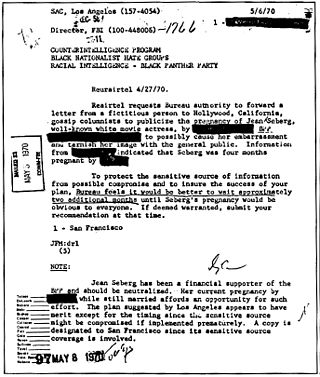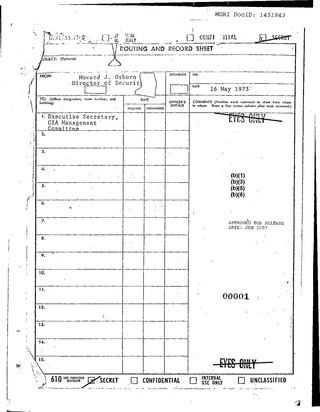Related Research Articles

COINTELPRO was a series of covert and illegal projects actively conducted by the United States Federal Bureau of Investigation (FBI) aimed at surveilling, infiltrating, discrediting, and disrupting domestic American political organizations. FBI records show COINTELPRO resources targeted groups and individuals the FBI deemed subversive, including feminist organizations, the Communist Party USA, anti–Vietnam War organizers, activists of the civil rights and Black power movements, environmentalist and animal rights organizations, the American Indian Movement (AIM), Chicano and Mexican-American groups like the Brown Berets and the United Farm Workers, independence movements, a variety of organizations that were part of the broader New Left, and white supremacist groups such as the Ku Klux Klan and the far-right group National States' Rights Party.

Surveillance is the monitoring of behavior, many activities, or information for the purpose of information gathering, influencing, managing or directing. This can include observation from a distance by means of electronic equipment, such as closed-circuit television (CCTV), or interception of electronically transmitted information like Internet traffic. It can also include simple technical methods, such as human intelligence gathering and postal interception.
Special Branch is a label customarily used to identify units responsible for matters of national security and intelligence in British, Commonwealth, Irish, and other police forces. A Special Branch unit acquires and develops intelligence, usually of a political or sensitive nature, and conducts investigations to protect the State from perceived threats of subversion, particularly terrorism and other extremist political activity.

Secret police are police, intelligence, or security agencies that engage in covert operations against a government's political, religious, or social opponents and dissidents. Secret police organizations are characteristic of authoritarian and totalitarian regimes. They protect the political power of a dictator or regime and often operate outside the law to repress dissidents and weaken political opposition, frequently using violence. They may enjoy legal sanction to hold and charge suspects without ever identifying their organization.
Political repression is the act of a state entity controlling a citizenry by force for political reasons, particularly for the purpose of restricting or preventing the citizenry's ability to take part in the political life of a society, thereby reducing their standing among their fellow citizens. Repression tactics target the citizenry who are most likely to challenge the political ideology of the state in order for the government to remain in control. In autocracies, the use of political repression is to prevent anti-regime support and mobilization. It is often manifested through policies such as human rights violations, surveillance abuse, police brutality, imprisonment, involuntary settlement, stripping of citizen's rights, lustration, and violent action or terror such as the murder, summary executions, torture, forced disappearance, and other extrajudicial punishment of political activists, dissidents, or general population. Direct repression tactics are those targeting specific actors who become aware of the harm done to them while covert tactics rely on the threat of citizenry being caught. The effectiveness of the tactics differ: covert repression tactics cause dissidents to use less detectable opposition tactics while direct repression allows citizenry to witness and react to the repression. Political repression can also be reinforced by means outside of written policy, such as by public and private media ownership and by self-censorship within the public.
The Handschu agreement is a set of guidelines that regulate police behavior in New York City with regard to political activity.
Surveillance abuse is the use of surveillance methods or technology to monitor the activity of an individual or group of individuals in a way which violates the social norms or laws of a society.
The Law Enforcement Intelligence Unit (LEIU) is an organization designed to facilitate intelligence sharing between state and local law enforcement agencies. It began in 1956 with 26 members and has since expanded to include roughly 250 members, mostly in the United States but also in Canada, Australia, and South Africa. The organization is divided into four zones: Eastern, Central, Northwestern, and Southwestern. According to its website, LEIU's purpose is to "gather, record, and exchange confidential information not available through regular police channels, concerning organized crime and terrorism."
Operation CHAOS or Operation MHCHAOS was a Central Intelligence Agency (CIA) domestic espionage project targeting American citizens operating from 1967 to 1974, established by President Lyndon B. Johnson and expanded under President Richard Nixon, whose mission was to uncover possible foreign influence on domestic race, anti-war, and other protest movements. The operation was launched under Director of Central Intelligence (DCI) Richard Helms by chief of counter-intelligence James Jesus Angleton, and headed by Richard Ober. The "MH" designation is to signify the program had a global area of operations.
Barbara Ellen Handschu is an American political activist and lawyer, whose surname was memorialized on a set of federal guidelines "[ordering] restrictions on police surveillance ... signed by the city [of New York] in 1985", which became known as the Handschu decree.

The "Family Jewels" is the name of a set of reports detailing illegal, inappropriate and otherwise sensitive activities conducted by the Central Intelligence Agency from 1959 to 1973. William Colby, the CIA director who received the reports, dubbed them the "skeletons in the CIA's closet". Most of the documents were released on June 25, 2007, after more than three decades of secrecy. The non-governmental National Security Archive filed a request for the documents under the Freedom of Information Act fifteen years before their release.

The Lower Manhattan Security Initiative (LMSI) is a New York City Police Department initiative overseen by the Counterterrorism Bureau to increase surveillance efforts in Lower Manhattan, New York City, New York, United States. It is housed in the Lower Manhattan Security Coordination Center (LMSCC) located at 55 Broadway. The LMSI covers a 1.7-mile area from Canal Street to Battery Park, including the New York Stock Exchange, World Financial Center, former World Trade Center site, and numerous financial institutions.

Throughout the history of the New York City Police Department, numerous instances of corruption, misconduct, and other allegations of such, have occurred. Over 12,000 cases have resulted in lawsuit settlements totaling over $400 million during a five-year period ending in 2014. In 2019, taxpayers funded $68,688,423 as the cost of misconduct lawsuits, a 76 percent increase over the previous year, including about $10 million paid out to two exonerated individuals who had been falsely convicted and imprisoned.
Frank Donner was a civil liberties lawyer, author, and the director of the American Civil Liberties Union's (ACLU) Project on Political Surveillance, whose clients included Morton Sobell and William Albertson.

The practice of mass surveillance in the United States dates back to wartime monitoring and censorship of international communications from, to, or which passed through the United States. After the First and Second World Wars, mass surveillance continued throughout the Cold War period, via programs such as the Black Chamber and Project SHAMROCK. The formation and growth of federal law-enforcement and intelligence agencies such as the FBI, CIA, and NSA institutionalized surveillance used to also silence political dissent, as evidenced by COINTELPRO projects which targeted various organizations and individuals. During the Civil Rights Movement era, many individuals put under surveillance orders were first labelled as integrationists, then deemed subversive, and sometimes suspected to be supportive of the communist model of the United States' rival at the time, the Soviet Union. Other targeted individuals and groups included Native American activists, African American and Chicano liberation movement activists, and anti-war protesters.

The New York Police Department's Strategic Response Group (SRG) is a unit of the New York City Police Department (NYPD) formed in 2015 for counter-terrorism and the policing of political protests. They maintain a bike squadron and are outfitted with anti-riot gear, rifles, and body armor. The unit has been criticized for its use of excessive force and mass arrests against political demonstrators protected under the First Amendment, disproportionately high numbers of complaints to the Civilian Complaint Review Board, and the killing of unarmed men, among other things. Activists, the New York City Council, the New York City Department of Investigation, and organizations such as Human Rights Watch and the New York Civil Liberties Union, among others, have called for its regulation or disbandment.

The New York City Police Department (NYPD) actively monitors public activity in New York City, New York, United States. Historically, surveillance has been used by the NYPD for a range of purposes, including against crime, counter-terrorism, and also for nefarious or controversial subjects such as monitoring political demonstrations, activities, and protests, and even entire ethnic and religious groups.

The New York City Police Department Intelligence Bureau is a division of the New York City Police Department (NYPD) which claims responsibility for the detection and disruption of criminal and terrorist activity through the use of intelligence-led policing. There is limited oversight over the Intelligence Bureau, and it conducts work in secrecy without the city council being informed of operations.
Defending Rights & Dissent (DRAD) is a national not-for-profit advocacy organization in the United States, dedicated to defending civil liberties, exposing government repression, and protecting the right of political dissent. DRAD was formed as the merger of the Defending Dissent Foundation (DDF) and the Bill of Rights Defense Committee (BORDC). DRAD is currently active in defending the right to protest, opposing political surveillance, and campaigning against the prosecution of national security whistleblowers.
References
- ↑ "Police Surveillance of Political Activity -- The History and Current State of the Handschu Decree". Testimony Of Arthur N. Eisenberg Presented To The New York Advisory Committee To The U.S. Commission On Civil Rights. New York Civil Liberties Union. May 21, 2003. Archived from the original on August 28, 2006. Retrieved February 19, 2007.
- ↑ "Blog Archive » They Pat Some Good Boys On the Back and Put Some to the Rod". Balloon Juice. 2012-03-24. Retrieved 2012-07-25.
- ↑ Report: NYPD infiltrated liberal groups
- ↑ http://www.randomcollection.info/gunderson.pdf [ dead link ]
- Frank J. Donner (1990). Protectors of privilege : red squads and police repression in urban America. University of California Press. ISBN 0-520-05951-4. Includes bibliographical references.
- Encyclopedia of Chicago: Red Squad
- Red Squad. Directed by Steven Fischler, Joel Sucher, Howard Blatt and Francis Freedland. USA, 1972, b/w, 45 min.